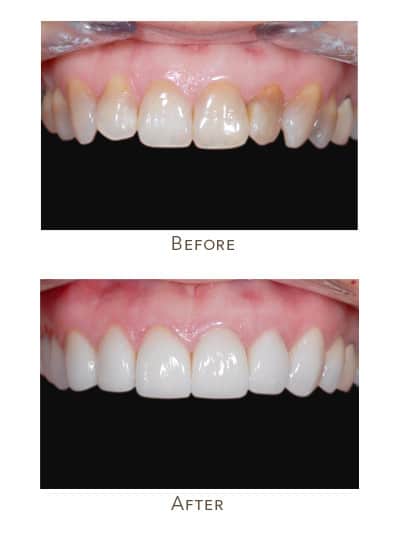If your attempts at teeth bleaching have yielded limited improvement in whiteness, you may be encountering intrinsic tooth discoloration specifically linked to tetracycline usage or elevated mineral consumption. Tetracycline, a broad-spectrum antibiotic introduced in 1948, addresses diverse bacterial infections. While effective in treating conditions such as skin, bowel, and urinary tract issues, its use during the developmental stages of tooth formation can lead to intrinsic tooth discoloration.
Tetracycline and Its Impact on Teeth Discoloration
Tetracycline is a medication that can combine with calcium ions and become incorporated into teeth, bones, and cartilage, leading to a brownish-gray discoloration of teeth or the appearance of horizontal stain bands. The discoloration can worsen when exposed to ultraviolet light, such as sunlight.
Thankfully, the scientific community has identified the potential causes of tooth discoloration, and doctors are now careful about prescribing Tetracycline to pregnant women and children.
Addressing Profound Teeth Discoloration or Tetracycline Stains
Tetracycline stains appear gray or dark brown on teeth and require a potent bleaching agent to achieve a whiter appearance. Although in-office teeth whitening can lighten tetracycline-stained teeth, the final result will depend on the initial color.

In general, Bleaching may not be very effective in these cases. While the white areas of the teeth may become significantly lighter, the dark stained areas typically do not show significant improvement.
If you have horizontal bands of gray stains, the gray colors will not discolor, the white areas of your teeth will lighten, and the horizontal bars will be more visible after bleaching.
Because of these limitations, we do not recommend using bleach on teeth stained with tetracycline. Even if minor improvements are possible, the results are often short-lived and can quickly revert.
Alternatives for Unsuccessful Whitening
If you are not satisfied with the results of professional teeth whitening, cosmetic dentistry provides options to improve the appearance of your teeth. Treatments like no prep (Lumineers) or porcelain veneers and crowns can be used to enhance the aesthetics of your teeth. These treatments are designed to give you a bright, healthy-looking smile to boost your confidence and self-esteem.
No-prep and traditional(porcelain) veneer treatments can conceal dark discoloration and provide a brighter, more uniform appearance to your teeth without stain bands.
Options for Improving Teeth Discoloration
Other dental treatments can help if teeth bleaching falls short of giving you the desired results for a brighter smile. Treatments like crowns or veneers can conceal tetracycline stains' dark color by bonding opaque porcelain to your teeth. However, it's essential to note that this approach may result in a less flexible outcome, as the porcelain must be crafted in a white and opaque manner to block the dark color effectively.
There are two types of veneers: no-prep (minimal) and traditional(porcelain) veneers. The traditional veneers are made of porcelain and require grinding down the tooth before attachment.
No-prep, as the name suggests; there are no tooth-shaving preparations necessary. The no-prep is no-tooth shaving veneers. Attach veneers onto the surface of the existing teeth to cover the underlying darkness or stains.
Applying no-prep veneers can sometimes create an artificial and temporary appearance for those with tetracycline-induced discoloration.

In contrast, traditional veneers or crowns with some tooth reduction may be necessary to achieve a more natural, translucent look. Since the dark color of the tetracycline stain tends to get darker as it penetrates deeper into the tooth, a thicker porcelain layer is required to block the color and create a translucent effect.
Choosing thicker veneers or crowns may result in a darker shade and an increased reduction of tooth structure, making it challenging to achieve a natural aesthetic.
Therefore, collaborating with an experienced cosmetic dentist and skilled laboratory technician becomes essential to minimize the reduction of tooth structure while achieving a natural-looking smile.
Opting for cosmetic dentistry involving crowns or veneers becomes a viable alternative when professional teeth bleaching results fall short of satisfaction. The success of this approach hinges on precise tooth preparation by the cosmetic dentist.
Inadequate preparation, with a shallow approach, may compromise the effectiveness of veneers in concealing dark stains, resulting in:
- Inability to block the dark color.
- A loss of the natural appearance due to thin, no-prep veneers.
- Potential for overly bulky teeth (veneers) to obscure the dark stain, sacrificing the natural transparency of the tooth.
Conversely, excessive tooth preparation risks weakening the teeth and, in the worst-case scenario, may necessitate root canal treatment. Therefore, meticulous attention to tooth preparation is essential to achieve optimal cosmetic results while preserving dental health.
Optimal Approaches for Veneers with Tetracycline-Stained Teeth
When contemplating the application of veneers to address tetracycline-stained teeth, it's crucial to recognize the importance of abstaining from teeth whitening before the procedure.
Although whitening teeth before veneer placement may be tempting, it's essential to understand that the whitening effect is temporary and will gradually diminish. Despite veneers concealing the dark tooth color, their surfaces exhibit translucency, and with time, the original tooth color may become visible as the whitening effect wanes.
As a best practice, avoiding teeth whitening before opting for veneers is advisable. When whitening has already occurred, a longer waiting period may be recommended before commencing the teeth stain treatment with veneers.
While altering the color of teeth through whitening or veneers may seem straightforward, achieving a natural-looking result with tetracycline-stained teeth involves careful consideration of various factors.
What About Extrinsic Stains
When teeth get stained from external factors like smoking, poor oral hygiene, or consuming dark beverages like coffee or wine, it leads to extrinsic stains. The discoloration appears on the surface of the teeth. Professional teeth whitening treatments like Zoom are highly effective in restoring the teeth' natural brightness. They use bleaching agents to lighten the stains. To avoid teeth stains, keep good oral hygiene, limit staining foods, and get regular teeth cleanings.



